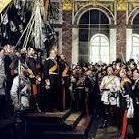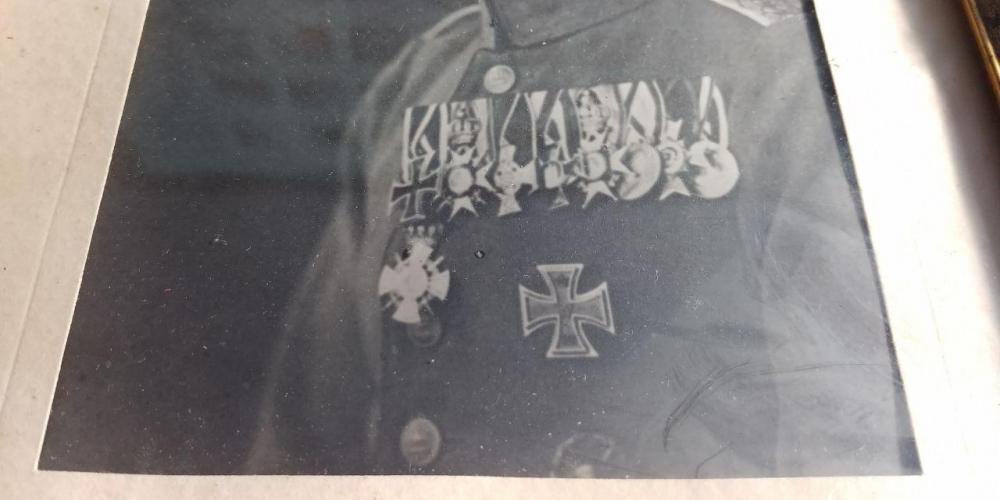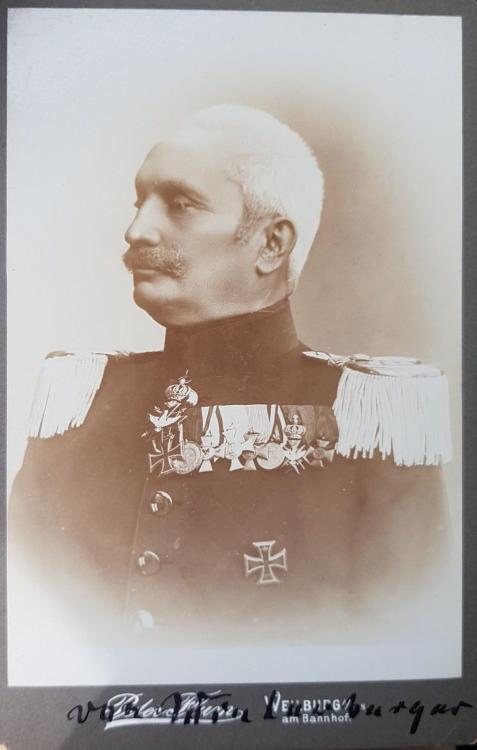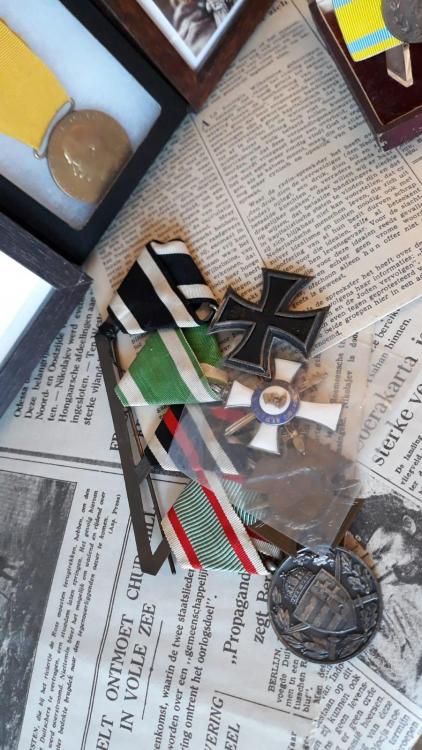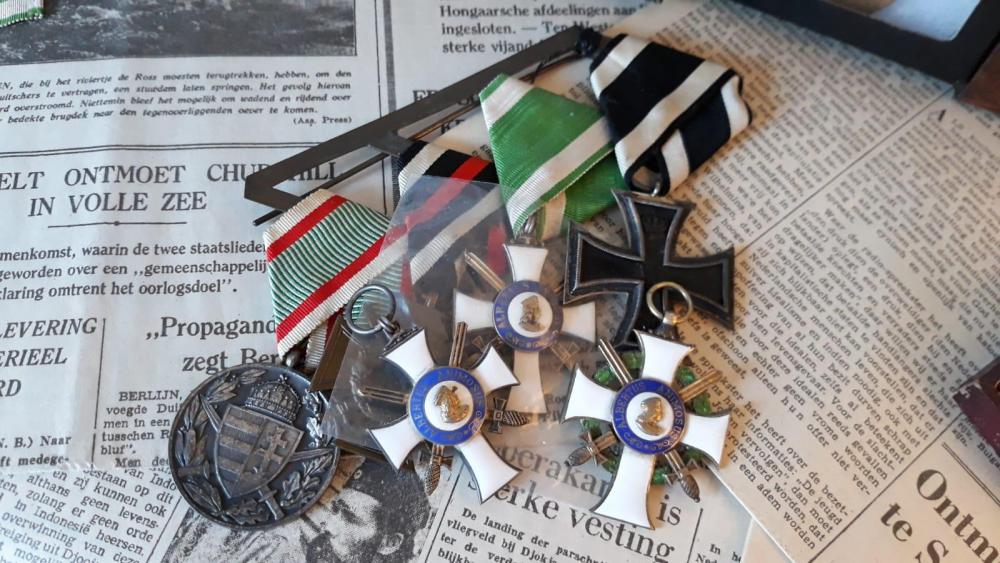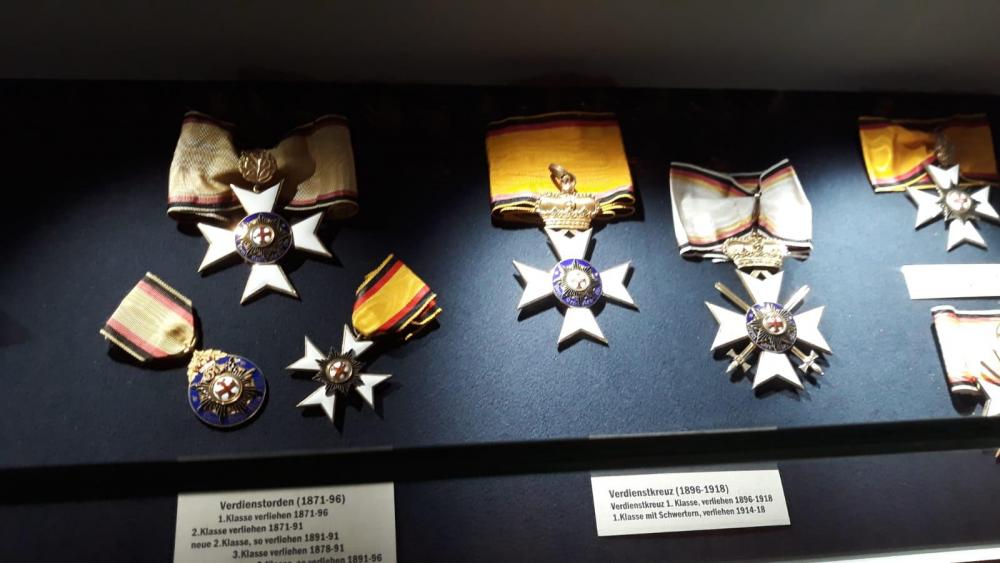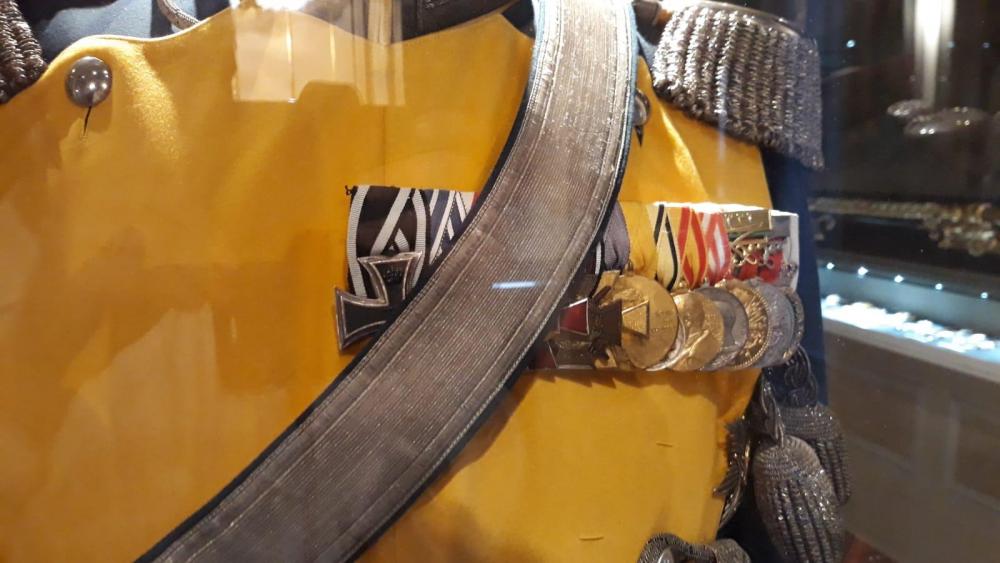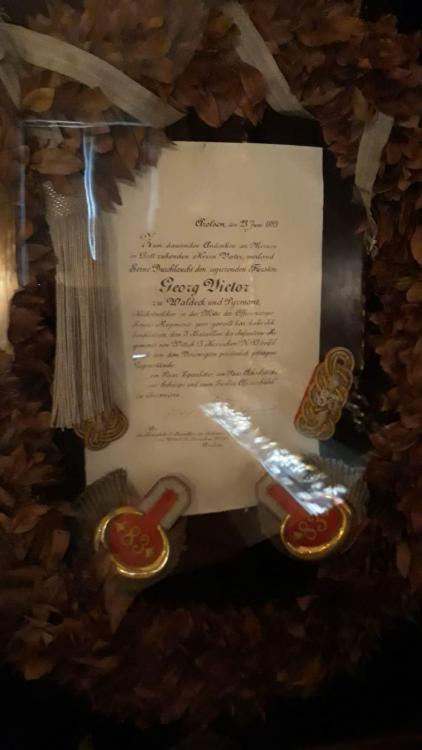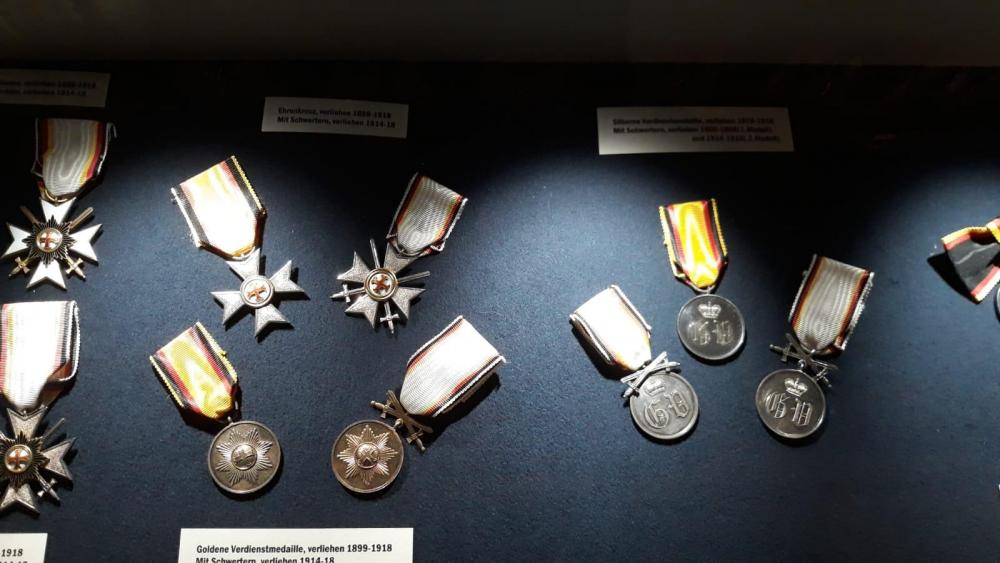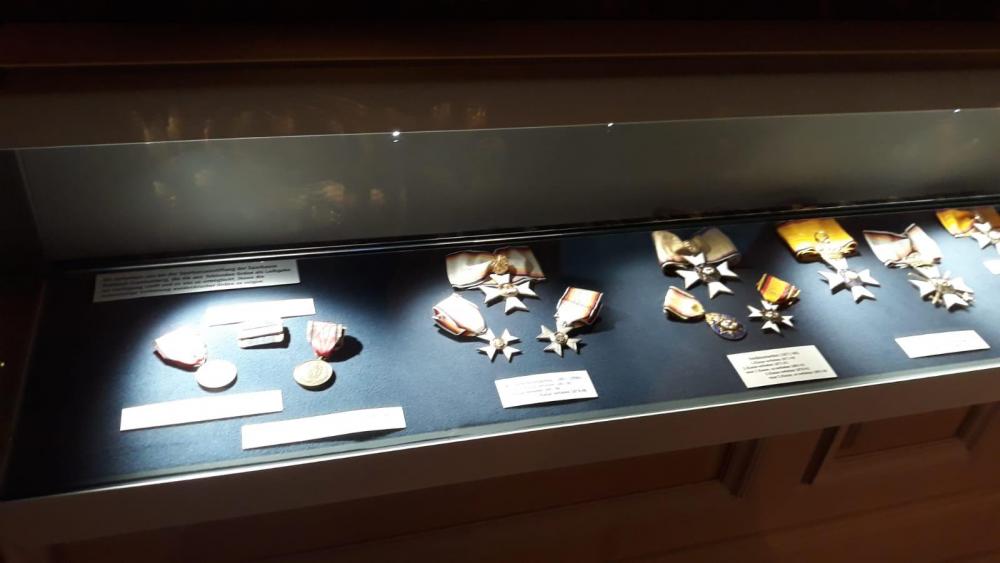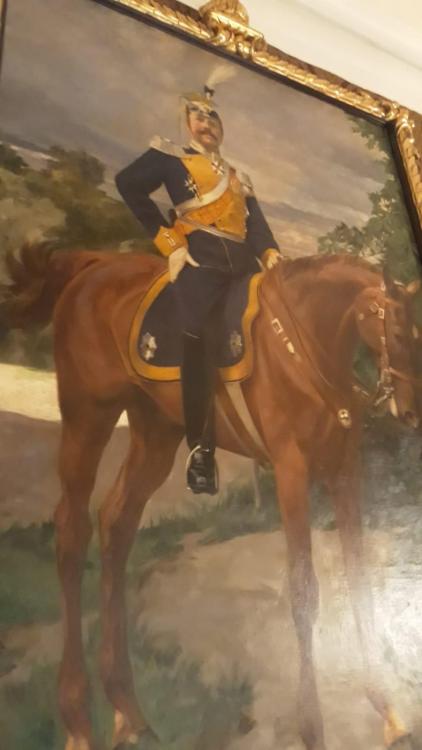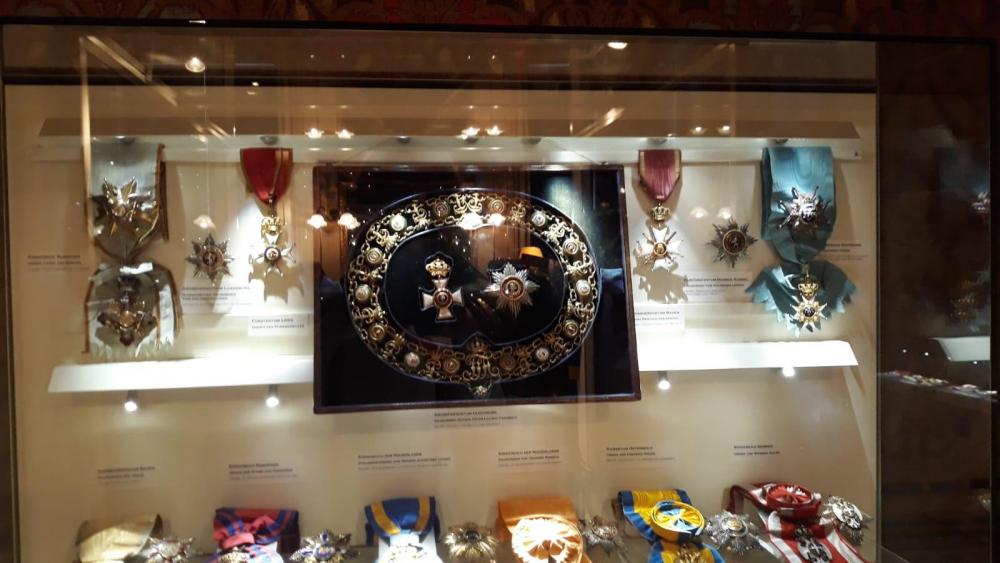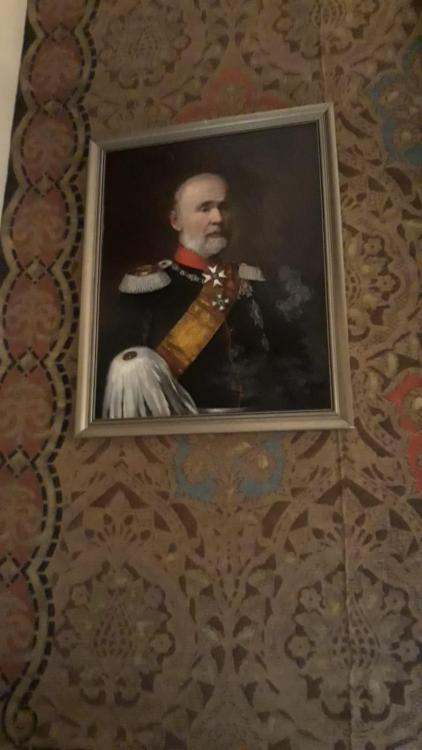-
Posts
674 -
Joined
-
Last visited
-
Days Won
6
Content Type
Profiles
Forums
Blogs
Gallery
Events
Store
Everything posted by laurentius
-
I agree with Nicolas, the blue ribbon is a Friedrichsorden with swords. A KO4x would need the ribbon of the Iron Cross. I also agree that the sixt ribbon from the right, squeezed in between the Bavarian Order of St. Michael and the Centenary-medal, is a Long Service award. I had the same idea as Claudio, this could very well be a ribbonbar which belonged to Ludendorff. Kind regards, Laurentius
-
Dear Utgardloki, I have seen several photographs and paintings of him in the past wearing his sashes in this style. Although it was customary to only wear one sash at the time I have seen many photos and paintings ranging from the Napoleonic Era untill now of people wearing two or more sashes. However, I have only seen this manner (cut sash attached to belt) with Wilhelm I. I wonder if there ever were others from his era (like him, veterans of the napoleonic war) who partook in this style? Kind regards, Laurentius
-
Dear fellow collectors, after looking through the Wikipedia-page of the new HBO shows 'Chernobyl' I ended up reading Wilhelm Röntgen's page and I found out that this German scientist had quite a number of decorations. Among these decorations were a Crownorder 2nd class, the Merit-Order of the holy Micheal and the Order of the Bavarian Crown. He is also listed as having received an Iron Cross 2nd class on the white-black ribbon (civilian). Did he get this award for actual participation on the homefront (he lived in Munich the entire war), or was this award given solely for his groundbreaking work in the area of radiology, which helped doctors treat the wounds of soldiers better? Kind regards, and thanks in advance, Laurentius
-
Dear Solomon, thanks for your correction, your help is always appreciated. Dear Komtur, I myself am not the owner of the picture, I asked for a German friend of mine. When I told him you would like to buy the picture I asked him for his e-mail address, which I will send to you in a private e-mail. Lovely bar btw. Kind regards, Laurentius
-
Dear Utgardloki, We are heading to the macabre part of collection-ethics here, but I feel that a fire is less troubling than theft. This only goes for metal decorations and awards ofcourse, it would be terrible for uniforms, paintings and portraits. Depending on the size of the fire and the airflow most medals would survive. Sure, most enameled and painted orders would have lost their recognizable part, not to mention the multi-constructed orders which use Schlelack (wax) to stay together like my beloved Albrechtsorden. Medals would survive the fire, how well they'd survive ofcourse fully depends on the material and the fire. Hindenburg lost almost all of his awards when his house burned down in the early 20's, yet I think most collectors would give a kidney to own one of these scorched medals (I'd like mine medium-rare please). Theft, in my opinion is far worse, when a fire hits, regardless of it's magnitude you'll always have a part of the collection which survives, which can't be said for theft, especially with cases being solved at a historical low (thanks Obama). I shudder at the thought of a medalbar being destroyed by thiefs (or collectors) solely for the purpose of profit. Often these medalbars are the last remaining piece of someone, and with it's destruction, they too, long after their death, cease to be. They live as long as we remember them, and in a way, honour them. That's the part which makes this hobby so great for me, there are lots of guys (and some girls) doing their best, reconstructing awardrolls, identifying medal- and ribbonbars, bringing back life to this great war. Kind regards, Laurentius
-
Dear Glenn J and 1812 Overture, thanks for your help, thanks to you we can put a name to this picture again. I do think it would be interesting to know which medals he is wearing in the sixth and eight place. 1812 Overture suggested the Regierungsjubiläumsmedaille 1902 but I don't think that's it. That medal has two big red stripes on the side of the ribbon which this medal misses. I think the ribbon is white with 2 small stripes of red perhaps? Kind regards, Laurentius
-
Dear fellow collectors, I would like to ask for help with identifying this senior officer, I believe the combination to be rare enough to make a correct identification. I was able to list most of his awards, to make things easier. The awards are as follows: -EK1 ( Iron Cross 1st class 1914) -VWA (1918 in black) -HoHx (House-Order of Hohenzollern with swords) -EK2 (Iron Cross 2nd class 1914) -EH/SEHOx (Saxe-Ernistine House-Order 1st class with swords) -LKr (Lippe-Detmold war merit cross) -HH (Hamburg Hanseatic Cross) -EH/SEHO (Saxe-Ernistine House-Order 2nd class) -Unknown -LH4 (Lippe-Detmold Princely Lippian House-Order) -Unknown Kind regards, and thanks in advance, Laurentius
-
Dear fellow collectors, I would like to ask for help with identifying this senior officer, I believe that it is possible to identify him due to his peculiar combination of orders. All help is appreciated. To make things easier I have already made a list of some of his awards, which is as follows: -GSF (House-Order of the white Falcon commanders cross) -EK1 ( Iron Cross 1st class 1870) -EK 2 ( Iron Cross 2nd class 1870) - Unknown -RAO4 ( Red Eagle Order 4th class, smooth arms, so awarded before 1879) -KO3 ( Crown order 3rd class) -LD25 (service-award for 25 years) -KDM (War memorial medal 1870-1871) -GSF1x ( House-Order of the white Falcon knightscross 1st class with swords) - unknown, Although I suspect it to be connected to the House-Order of the white Falcon Kind regards, and thanks in advance, Laurentius
-
Dear Utgardloki, I have seen often in the past how even being sown down isn't enough to save a history. A German collector who is also active on this forum ( I have sadly forgotten his name) owned several named high-ranking medalbars. When they were stolen when he was at a concert they were reported to the police, as someone would normally do. Months later he heard that airport-photos proved the had been shipped off to Turkey, to be cut up. Sometimes when I'm browsing GMIC, WAF or Facebook I come across a medalbar which I recognize, either from an auctionhouse a few years ago, or perhaps a reference-book. Sadly, when I'm browsing dealers, auctionsites or Ebay I see medalbars without medals, and I recall seeing them earlier, still in their full glory. I have been know to be a bit of a purist when it comes to splitting up groups and adding things together, but I don't regard the adding of ribbons as wrong, but something necessary to show how it looked 100 years ago. These kinds of questions, important questions, form the centre of the ethics of the collector. What is, and what is acceptable in this collection-area, and how far one should go to achieve profit? Kind regards, Laurentius
-
Dear Utgardloki, adding a ribbon isn't a bad thing in my opinion, whether it's a sash for a grandcross or just a bit of ribbon for a regular medal. I know that I do, and that other collectors too, have a list of ribbons they want to buy for medals they have. Adding a ribbon just completes the picture. I agree that there should be a mention that the sash is not original to the star. Kind regards, Laurentius
-
Dear fellow collectors, here is my latest acquisition, a Saxon frackspange made after 1934. Saxon spanges in this style are rare, especially when made after 1933. The second picture is with my other Albrechtsorden. The albrechtsorden on the bar is made by Roesner, and the other two are from Scharffenberg. Kind regards, Laurentius
-
Dear fellow collectors, recently I was talking to a number of German collectors about pre-ww1 uniforms, when one of the collectors stepped forward and told me he was the great-great-grandson of Johann Heinrich Gottfried von Wodtke (1837-1907) and that his Great-Great-Grandfather was a Generalleutnant. He showed me a picture and asked me if I could perhaps tell him his ancestor's awards, which I promptly did. After telling him which kinds of highranking orders he had recieved he got enthustiac and asked me if I could tell him more, I couldn't but I wondered if any of you could perhaps help him on his quest to learn more. Here is a picture of him, and I will list all info we have at this moment. We know that his rank was Generalleutnant, and that he was ennobled (the 'von' in his name), we know he lived from 1837 untill 1907 and that his son Georg was a Generalmajor (1864-1942). He fought in the Austro-German war and took part in the battle of Königgratz, and he took part in the Franco-Prussian war (receiving both classes of the Iron Cross and perhaps the RAO4X, although that could also have been during the Austro-German war). His awards are as follows: * Red Eagle Order 2. class Schwertern am Ring * Bavarian Military Merit Order 2. class * Crown Order 1. class sash and star * Red Eagle Order 2. class star Schwertern am Ring * Unknown award hidden under the sash of the Crown Order * Iron Cross 1870 both classes * Red Eagle Order 4. class with swords * Long service award for 25 years * Medal for the Franco-Prussian war with clasps * Cross for the battle of Königgratz * Centenary-medal We know this picture was taken during the last 10 years of his life, we also know he served atleast for some time in IR 76. We would be grateful for any info regarding his decorations, ranks and Dienststelle. Kind regards, and thanks in advance, Laurentius
-
Dear 1812 ouverture, I do not know who this is, but I do not see any award on his medalbar which predates WW1. A pretty interesting combination of awards. An iron cross, followed by a Hessian medal for bravery, a Waldeck-Pyrmont Verdienstkreuz, Friedrichsorden, Lübeck Hanseatenkreuz, Austrian MVK and some other awards. The combination of the medalbar is probably not unique (I think) but with this rare chinese order we might yet find it who this is. We know for sure that he served in WW2 and that he was decorated (KVK1). This already helps with the identification. Kind regards, Laurentius P.S. I now see that he has a Waldeck-Pyrmont Verdienstkreuz 3rd class with swords, it is possible he had the 4th class without swords, which was updated during the war.
-
Dear Greyc, there were plenty officers, but also NCO's and sometimes (but rarely) even regular soldiers with more than one 'steckkreuz'. Although most recipients of multiple of these steckkreuzes only wore one at the time, you can sometimes find pictures of officers wearing 2 or 3. It's a bit like neck-orders, most keep it to one, but there are always people who want to brag ? Kind regards, Laurentius
-
Dear fellow collectors, I recently visited Residenzschloss Arolsen in Bad Arolsen, it used to be the main residence for the Waldeck-Pyrmont family who ruled the German principality of Waldeck-Pyrmont. I went there because of my love of medals, and my love of the Dutch Royal family (Queen-regent Emma was born here). I was able to make a number of pictures, and I'm sure you lads would enjoy them. Kind regards, Laurentius
-
Dear fellow collectors, the precedence on this medalbar is correct, the Russian Order of St. George, just like the Austrian order of Maria Therese, took precedence over most German awards. This tradition came into place after the napoleonic wars, because many German officers had received Russian and Austrian decorations. Although the combination and precedence might seem wrong, they are indeed correct, and I might even go as far as say that this medalbar belonged to a high-ranking Badener, most likely someone from the Grandduchal house. None of you untill now seem to have noticed the most important and the rarest decoration on this bar. It is not the Order of St. George, small hint, it's in the 6th place. Kind regards, Laurentius
-
Dear VtwinVince, I think our Chinese friend meant to ask how persons who already have a medalbar update their medalbar. Which is quite simple to answer. Let's say we have a Prussian captain, he has a three-piece medalbar with an RAO, KO and LS. This is a completely normal peace-time combination for a Prussian. In 1897 he gets a centenary-medal. He could update his medalbar by bringing the medalbar to a jeweler (like Godet, or any of the other jewelers who also mounted). He decides however, that since he considers the notion too expensive, to leave it be untill he gets another award. With the centenary-medal, there is not much prestige, so not all persons chose to update. Different scenario: we have the same captain, now in 1915. He has in the meanwhile amassed several other orders. He receives an EK2. Feeling that this is an important decoration (it is, fight me?) he choses to update his medalbar immediately. This is what it boils down to in essence. Regardless of whether it is a single-medalbar or a medalbar with several awards, whether it was updated was decided by the owner, based on the prestige of awards and the cost of remounting. (very expensive at the time, prices ranged but sometimes the cost was equal to several weeks of rent in certain Berlin neighbourhoods). I hope this explains the topic to you, 1812 ouverture. For as far as I know you didn't have to proof you owned the medals, you just had to bring them in for mounting. Kind regards, Laurentius
-
Dear fellow collectors, I recently stumbled upon the career of Marie Johan Teixeira de Mattos, a Dutchman who served in the German army during WW1, in the cavalry regiment 'Königin Wilhelmina der Niederlande'. After having served a few months on the western front he and his regiment were moved to the eastern front, just in time to take part in the Battle of Tannenberg. Do any of you know his awards? I know he was a knight in the Dutch order of Oranje-Nassau, and that he was a knight in the Johanniter-Orden. Kind regards, and thanks in advance, Laurentius


